#java application types
Explore tagged Tumblr posts
Text
almost definitely gonna actually for-fucking-realsies pass my courses this term and GRADUATE finallyyy ! ! !
#still have an exam tmrw and theres still a chance i wontve done well enough on that last java assignment but#balance of probabilities ill pass these 2 courses!!!!!#and now. the dreaded Job SearchTM#trying very very hard 2 hold on 2 the Joy (graduating!!!!!) and NOT succumb 2 the Dread (staring down the barrel of 30+ yrs of career hell)#i see the job listings with 'software development' in the title and i cry. i see the salary ranges and i cry some more#why does a thing i have so little interest in pay so well compared 2 anything id actually rather do#im not. categorically opposed 2 all IT type jobs i just. dont wanna do application development. pls god PLS#let me work on like the old as shit systems...... i dont wanna make new shit :((((#2 clarify i am ONLY applying for GC jobs id never survive in private industry#the application process on the gc.jobs site is..... so..... tedious tho :(
1 note
·
View note
Text
you read ML research (e.g. arxiv, state of ai, various summaries), you find an overwhelming blizzard of new techniques, clever new applications and combinations of existing techniques, new benchmarks to refine this or that limitation, relentless jumps in capabilities that seem unstoppable (e.g. AI video generation took off way faster than I ever anticipated). at some point you start to see how Károly Zsolnai-Fehér became such a parody of himself!
you read ed zitron & similar writers and you hear about an incomprehensibly unprofitable industry, an obscene last-gasp con from a cancerous, self-cannibalising tech sector that seems poised to take the rest of the system down with it once the investors realise nobody actually cares to pay for AI anything like what it costs to run. and you think, while perhaps he presents the most negative possible read on what the models are capable of, it's hard to disagree with his analysis of the economics.
you read lesswrong & cousins, and everyone's talking about shoggoths wearing masks and the proper interpretation of next-token-prediction as they probe the LLMs for deceptive behaviour with an atmosphere of paranoid but fascinated fervour. or else compile poetic writing with a mystic air as they celebrate a new form of linguistic life. and sooner or later someone will casually say something really offputting about eugenics. they have fiercely latched onto playing with the new AI models, and some users seem to have better models than most of how they do what they do. but their whole deal from day 1 was conjuring wild fantasies about AI gods taking over the world (written in Java of course) and telling you how rational they are for worrying about this. so... y'know.
you talk to an actual LLM and it produces a surprisingly sharp, playful and erudite conversation about philosophy of mind and an equally surprising ability to carry out specific programming tasks and pull up deep cuts, but you have to be constantly on guard against the inherent tendency to bullshit, to keep in mind what the LLM can't do and learn how to elicit the type of response you want and clean up its output. is it worth the trouble? what costs should be borne to see such a brilliant toy, an art piece that mirrors a slice of the human mind?
you think about the news from a few months ago where israel claimed to be using an AI model to select palestinians in gaza to kill with missiles and drones. an obscene form of statswashing, but they'd probably kill about the same number of people, equally at random, regardless. probably more of that to come. the joke of all the 'constitutional AI', 'helpful harmless assistant' stuff is that the same techniques would work equally well to make the model be anything you want. that twat elon musk already made a racist LLM.
one day the present AI summer and corresponding panics will burn out, and all this noise will cohere into a clear picture of what these new ML techniques are actually good for and what they aren't. we'll have a pile of trained models, probably some work on making them smaller and more efficient to run, and our culture will have absorbed their existence and figured out a suitable set of narratives and habits around using them in this or that context. but i'm damned if I know how it will look by then, and what we'll be left with after the bubble.
if i'm gonna spend all this time reading shit on my computer i should get back to umineko lmao
252 notes
·
View notes
Text
Rambling About C# Being Alright
I think C# is an alright language. This is one of the highest distinctions I can give to a language.
Warning: This post is verbose and rambly and probably only good at telling you why someone might like C# and not much else.
~~~
There's something I hate about every other language. Worst, there's things I hate about other languages that I know will never get better. Even worse, some of those things ALSO feel like unforced errors.
With C# there's a few things I dislike or that are missing. C#'s feature set does not obviously excel at anything, but it avoids making any huge misstep in things I care about. Nothing in C# makes me feel like the language designer has personally harmed me.
C# is a very tolerable language.
C# is multi-paradigm.
C# is the Full Middle Malcomist language.
C# will try to not hurt you.
A good way to describe C# is "what if Java sucked less". This, of course, already sounds unappealing to many, but that's alright. I'm not trying to gas it up too much here.
C# has sins, but let's try to put them into some context here and perhaps the reason why I'm posting will become more obvious:
C# didn't try to avoid generics and then implement them in a way that is very limiting (cough Go).
C# doesn't hamstring your ability to have statement lambdas because the language designer dislikes them and also because the language designer decided to have semantic whitespace making statement lambdas harder to deal with (cough Python).
C# doesn't require you to explicitly wrap value types into reference types so you can put value types into collections (cough Java).
C# doesn't ruin your ability to interact with memory efficiently because it forbids you from creating custom value types, ergo everything goes to the heap (cough cough Java, Minecraft).
C# doesn't have insane implicit type coercions that have become the subject of language design comedy (cough JavaScript).
C# doesn't keep privacy accessors as a suggestion and has the developers pinkie swear about it instead of actually enforcing it (cough cough Python).
Plainly put, a lot of the time I find C# to be alright by process of elimination. I'm not trying to shit on your favorite language. Everyone has different things they find tolerable. I have the Buddha nature so I wish for all things to find their tolerable language.
I do also think that C# is notable for being a mainstream language (aka not Haskell) that has a smaller amount of egregious mistakes, quirks and Faustian bargains.
The Typerrrrr
C# is statically typed, but the typing is largely effortless to navigate unlike something like Rust, and the GC gives a greater degree of safety than something like C++.
Of course, the typing being easy to work it also makes it less safe than Rust. But this is an appropriate trade-off for certain kinds of applications, especially considering that C# is memory safe by virtue of running on a VM. Don't come at me, I'm a Rust respecter!!
You know how some people talk about Python being amazing for prototyping? That's how I feel about C#. No matter how much time I would dedicate to Python, C# would still be a more productive language for me. The type system would genuinely make me faster for the vast majority of cases. Of course Python has gradual typing now, so any comparison gets more difficult when you consider that. But what I'm trying to say is that I never understood the idea that doing away entirely with static typing is good for fast iteration.
Also yes, C# can be used as a repl. Leave me alone with your repls. Also, while the debugger is active you can also evaluate arbitrary code within the current scope.
I think that going full dynamic typing is a mistake in almost every situation. The fact that C# doesn't do that already puts it above other languages for me. This stance on typing is controversial, but it's my opinion that is really shouldn't be. And the wind has constantly been blowing towards adding gradual typing to dynamic languages.
The modest typing capabilities C# coupled with OOP and inheritance lets you create pretty awful OOP slop. But that's whatever. At work we use inheritance in very few places where it results in neat code reuse, and then it's just mostly interfaces getting implemented.
C#'s typing and generic system is powerful enough to offer you a plethora of super-ergonomic collection transformation methods via the LINQ library. There's a lot of functional-style programming you can do with that. You know, map, filter, reduce, that stuff?
Even if you make a completely new collection type, if it implements IEnumerable<T> it will benefit from LINQ automatically. Every language these days has something like this, but it's so ridiculously easy to use in C#. Coupled with how C# lets you (1) easily define immutable data types, (2) explicitly control access to struct or class members, (3) do pattern matching, you can end up with code that flows really well.
A Friendly Kitchen Sink
Some people have described C#'s feature set as bloated. It is getting some syntactic diversity which makes it a bit harder to read someone else's code. But it doesn't make C# harder to learn, since it takes roughly the same amount of effort to get to a point where you can be effective in it.
Most of the more specific features can be effortlessly ignored. The ones that can't be effortlessly ignored tend to bring something genuinely useful to the language -- such as tuples and destructuring. Tuples have their own syntax, the syntax is pretty intuitive, but the first time you run into it, you will have to do a bit of learning.
C# has an immense amount of small features meant to make the language more ergonomic. They're too numerous to mention and they just keep getting added.
I'd like to draw attention to some features not because they're the most important but rather because it feels like they communicate the "personality" of C#. Not sure what level of detail was appropriate, so feel free to skim.
Stricter Null Handling. If you think not having to explicitly deal with null is the billion dollar mistake, then C# tries to fix a bit of the problem by allowing you to enable a strict context where you have to explicitly tell it that something can be null, otherwise it will assume that the possibility of a reference type being null is an error. It's a bit more complicated than that, but it definitely helps with safety around nullability.
Default Interface Implementation. A problem in C# which drives usage of inheritance is that with just interfaces there is no way to reuse code outside of passing function pointers. A lot of people don't get this and think that inheritance is just used because other people are stupid or something. If you have a couple of methods that would be implemented exactly the same for classes 1 through 99, but somewhat differently for classes 100 through 110, then without inheritance you're fucked. A much better way would be Rust's trait system, but for that to work you need really powerful generics, so it's too different of a path for C# to trod it. Instead what C# did was make it so that you can write an implementation for methods declared in an interface, as long as that implementation only uses members defined in the interface (this makes sense, why would it have access to anything else?). So now you can have a default implementation for the 1 through 99 case and save some of your sanity. Of course, it's not a panacea, if the implementation of the method requires access to the internal state of the 1 through 99 case, default interface implementation won't save you. But it can still make it easier via some techniques I won't get into. The important part is that default interface implementation allows code reuse and reduces reasons to use inheritance.
Performance Optimization. C# has a plethora of features regarding that. Most of which will never be encountered by the average programmer. Examples: (1) stackalloc - forcibly allocate reference types to the stack if you know they won't outlive the current scope. (2) Specialized APIs for avoiding memory allocations in happy paths. (3) Lazy initialization APIs. (4) APIs for dealing with memory more directly that allow high performance when interoping with C/C++ while still keeping a degree of safety.
Fine Control Over Async Runtime. C# lets you write your own... async builder and scheduler? It's a bit esoteric and hard to describe. But basically all the functionality of async/await that does magic under the hood? You can override that magic to do some very specific things that you'll rarely need. Unity3D takes advantage of this in order to allow async/await to work on WASM even though it is a single-threaded environment. It implements a cooperative scheduler so the program doesn't immediately freeze the moment you do await in a single-threaded environment. Most people don't know this capability exists and it doesn't affect them.
Tremendous Amount Of Synchronization Primitives and API. This ones does actually make multithreaded code harder to deal with, but basically C# erred a lot in favor of having many different ways to do multithreading because they wanted to suit different usecases. Most people just deal with idiomatic async/await code, but a very small minority of C# coders deal with locks, atomics, semaphores, mutex, monitors, interlocked, spin waiting etc. They knew they couldn't make this shit safe, so they tried to at least let you have ready-made options for your specific use case, even if it causes some balkanization.
Shortly Begging For Tagged Unions
What I miss from C# is more powerful generic bounds/constraints and tagged unions (or sum types or discriminated unions or type unions or any of the other 5 names this concept has).
The generic constraints you can use in C# are anemic and combined with the lack of tagged unions this is rather painful at times.
I remember seeing Microsoft devs saying they don't see enough of a usecase for tagged unions. I've at times wanted to strangle certain people. These two facts are related to one another.
My stance is that if you think your language doesn't need or benefit from tagged unions, either your language is very weird, or, more likely you're out of your goddamn mind. You are making me do really stupid things every time I need to represent a structure that can EITHER have a value of type A or a value of type B.
But I think C# will eventually get tagged unions. There's a proposal for it here. I would be overjoyed if it got implemented. It seems like it's been getting traction.
Also there was an entire section on unchecked exceptions that I removed because it wasn't interesting enough. Yes, C# could probably have checked exceptions and it didn't and it's a mistake. But ultimately it doesn't seem to have caused any make-or-break in a comparison with Java, which has them. They'd all be better off with returning an Error<T>. Short story is that the consequences of unchecked exceptions have been highly tolerable in practice.
Ecosystem State & FOSSness
C# is better than ever and the tooling ecosystem is better than ever. This is true of almost every language, but I think C# receives a rather high amount of improvements per version. Additionally the FOSS story is at its peak.
Roslyn, the bedrock of the toolchain, the compiler and analysis provider, is under MIT license. The fact that it does analysis as well is important, because this means you can use the wealth of Roslyn analyzers to do linting.
If your FOSS tooling lets you compile but you don't get any checking as you type, then your development experience is wildly substandard.
A lot of stupid crap with cross-platform compilation that used to be confusing or difficult is now rather easy to deal with. It's basically as easy as (1) use NET Core, (2) tell dotnet to build for Linux. These steps take no extra effort and the first step is the default way to write C# these days.
Dotnet is part of the SDK and contains functionality to create NET Core projects and to use other tools to build said projects. Dotnet is published under MIT, because the whole SDK and runtime are published under MIT.
Yes, the debugger situation is still bad -- there's no FOSS option for it, but this is more because nobody cares enough to go and solve it. Jetbrains proved anyone can do it if they have enough development time, since they wrote a debugger from scratch for their proprietary C# IDE Rider.
Where C# falls flat on its face is the "userspace" ecosystem. Plainly put, because C# is a Microsoft product, people with FOSS inclinations have steered clear of it to such a degree that the packages you have available are not even 10% of what packages a Python user has available, for example. People with FOSS inclinations are generally the people who write packages for your language!!
I guess if you really really hate leftpad, you might think this is a small bonus though.
Where-in I talk about Cross-Platform
The biggest thing the ecosystem has been lacking for me is a package, preferably FOSS, for developing cross-platform applications. Even if it's just cross-platform desktop applications.
Like yes, you can build C# to many platforms, no sweat. The same way you can build Rust to many platforms, some sweat. But if you can't show a good GUI on Linux, then it's not practically-speaking cross-platform for that purpose.
Microsoft has repeatedly done GUI stuff that, predictably, only works on Windows. And yes, Linux desktop is like 4%, but that 4% contains >50% of the people who create packages for your language's ecosystem, almost the exact point I made earlier. If a developer runs Linux and they can't have their app run on Linux, they are not going to touch your language with a ten foot pole for that purpose. I think this largely explains why C#'s ecosystem feels stunted.
The thing is, I'm not actually sure how bad or good the situation is, since most people just don't even try using C# for this usecase. There's a general... ecosystem malaise where few care to use the language for this, chiefly because of the tone that Microsoft set a decade ago. It's sad.
HOWEVER.
Avalonia, A New Hope?
Today we have Avalonia. Avalonia is an open-source framework that lets you build cross-platform applications in C#. It's MIT licensed. It will work on Windows, macOS, Linux, iOS, Android and also somehow in the browser. It seems to this by actually drawing pixels via SkiaSharp (or optionally Direct2D on Windows).
They make money by offering migration services from WPF app to Avalonia. Plus general support.
I can't say how good Avalonia is yet. I've researched a bit and it's not obviously bad, which is distinct from being good. But if it's actually good, this would be a holy grail for the ecosystem:
You could use a statically typed language that is productive for this type of software development to create cross-platform applications that have higher performance than the Electron slop. That's valuable!
This possibility warrants a much higher level of enthusiasm than I've seen, especially within the ecosystem itself. This is an ecosystem that was, for a while, entirely landlocked, only able to make Windows desktop applications.
I cannot overstate how important it is for a language's ecosystem to have a package like this and have it be good. Rust is still missing a good option. Gnome is unpleasant to use and buggy. Falling back to using Electron while writing Rust just seems like a bad joke. A lot of the Rust crates that are neither Electron nor Gnome tend to be really really undercooked.
And now I've actually talked myself into checking out Avalonia... I mean after writing all of that I feel like a charlatan for not having investigated it already.
72 notes
·
View notes
Text
The C Programming Language Compliers – A Comprehensive Overview
C is a widespread-purpose, procedural programming language that has had a profound have an impact on on many different contemporary programming languages. Known for its efficiency and energy, C is frequently known as the "mother of all languages" because many languages (like C++, Java, and even Python) have drawn inspiration from it.
C Lanugage Compliers

Developed within the early Seventies via Dennis Ritchie at Bell Labs, C changed into firstly designed to develop the Unix operating gadget. Since then, it has emerge as a foundational language in pc science and is still widely utilized in systems programming, embedded systems, operating systems, and greater.
2. Key Features of C
C is famous due to its simplicity, performance, and portability. Some of its key functions encompass:
Simple and Efficient: The syntax is minimalistic, taking into consideration near-to-hardware manipulation.
Fast Execution: C affords low-degree get admission to to memory, making it perfect for performance-critical programs.
Portable Code: C programs may be compiled and run on diverse hardware structures with minimal adjustments.
Rich Library Support: Although simple, C presents a preferred library for input/output, memory control, and string operations.
Modularity: Code can be written in features, improving readability and reusability.
Extensibility: Developers can without difficulty upload features or features as wanted.
Three. Structure of a C Program
A primary C application commonly consists of the subsequent elements:
Preprocessor directives
Main function (main())
Variable declarations
Statements and expressions
Functions
Here’s an example of a easy C program:
c
Copy
Edit
#include <stdio.H>
int important()
printf("Hello, World!N");
go back zero;
Let’s damage this down:
#include <stdio.H> is a preprocessor directive that tells the compiler to include the Standard Input Output header file.
Go back zero; ends this system, returning a status code.
4. Data Types in C
C helps numerous facts sorts, categorised particularly as:
Basic kinds: int, char, glide, double
Derived sorts: Arrays, Pointers, Structures
Enumeration types: enum
Void kind: Represents no fee (e.G., for functions that don't go back whatever)
Example:
c
Copy
Edit
int a = 10;
waft b = three.14;
char c = 'A';
five. Control Structures
C supports diverse manipulate structures to permit choice-making and loops:
If-Else:
c
Copy
Edit
if (a > b)
printf("a is more than b");
else
Switch:
c
Copy
Edit
switch (option)
case 1:
printf("Option 1");
smash;
case 2:
printf("Option 2");
break;
default:
printf("Invalid option");
Loops:
For loop:
c
Copy
Edit
printf("%d ", i);
While loop:
c
Copy
Edit
int i = 0;
while (i < five)
printf("%d ", i);
i++;
Do-even as loop:
c
Copy
Edit
int i = zero;
do
printf("%d ", i);
i++;
while (i < 5);
6. Functions
Functions in C permit code reusability and modularity. A function has a return kind, a call, and optionally available parameters.
Example:
c
Copy
Edit
int upload(int x, int y)
go back x + y;
int important()
int end result = upload(3, 4);
printf("Sum = %d", result);
go back zero;
7. Arrays and Strings
Arrays are collections of comparable facts types saved in contiguous memory places.
C
Copy
Edit
int numbers[5] = 1, 2, three, 4, five;
printf("%d", numbers[2]); // prints three
Strings in C are arrays of characters terminated via a null character ('').
C
Copy
Edit
char name[] = "Alice";
printf("Name: %s", name);
8. Pointers
Pointers are variables that save reminiscence addresses. They are powerful but ought to be used with care.
C
Copy
Edit
int a = 10;
int *p = &a; // p factors to the address of a
Pointers are essential for:
Dynamic reminiscence allocation
Function arguments by means of reference
Efficient array and string dealing with
9. Structures
C
Copy
Edit
struct Person
char call[50];
int age;
;
int fundamental()
struct Person p1 = "John", 30;
printf("Name: %s, Age: %d", p1.Call, p1.Age);
go back 0;
10. File Handling
C offers functions to study/write documents using FILE pointers.
C
Copy
Edit
FILE *fp = fopen("information.Txt", "w");
if (fp != NULL)
fprintf(fp, "Hello, File!");
fclose(fp);
11. Memory Management
C permits manual reminiscence allocation the usage of the subsequent functions from stdlib.H:
malloc() – allocate reminiscence
calloc() – allocate and initialize memory
realloc() – resize allotted reminiscence
free() – launch allotted reminiscence
Example:
c
Copy
Edit
int *ptr = (int *)malloc(five * sizeof(int));
if (ptr != NULL)
ptr[0] = 10;
unfastened(ptr);
12. Advantages of C
Control over hardware
Widely used and supported
Foundation for plenty cutting-edge languages
thirteen. Limitations of C
No integrated help for item-oriented programming
No rubbish collection (manual memory control)
No integrated exception managing
Limited fashionable library compared to higher-degree languages
14. Applications of C
Operating Systems: Unix, Linux, Windows kernel components
Embedded Systems: Microcontroller programming
Databases: MySQL is partly written in C
Gaming and Graphics: Due to performance advantages
2 notes
·
View notes
Text
Join the Elm SMP!
Hi hello!! Me and my friend @mouseshift are currently trying to make a minecraft java server and are currently looking for players (aged 16+) that would be interested in joining. This server is going to have roleplay elements and a handful of mods, while still sticking to a vanilla type feeling. Since the server is in such an early state, we're also asking what type of mods players would like. This would help us get an overall vibe for the server as we set it up! We're pretty friendly people and aren't too picky about who joins. If you're comfortable playing and collaborating with other people, feel free to fill out this form. We're looking to make friends and make sure that no one feels left out !!! A discord server will be made later to develop the smp more and talk to everyone! :-]
#minecraft#minecraft server#minecraft smp#minecraft java#server application#my textbox#PLWASE PLEASE LPESAP LELPASEELP PLEASE PLEAS#waves#java smp#umm#elm smp
16 notes
·
View notes
Text
Mastering Data Structures: A Comprehensive Course for Beginners
Data structures are one of the foundational concepts in computer science and software development. Mastering data structures is essential for anyone looking to pursue a career in programming, software engineering, or computer science. This article will explore the importance of a Data Structure Course, what it covers, and how it can help you excel in coding challenges and interviews.
1. What Is a Data Structure Course?
A Data Structure Course teaches students about the various ways data can be organized, stored, and manipulated efficiently. These structures are crucial for solving complex problems and optimizing the performance of applications. The course generally covers theoretical concepts along with practical applications using programming languages like C++, Java, or Python.
By the end of the course, students will gain proficiency in selecting the right data structure for different problem types, improving their problem-solving abilities.
2. Why Take a Data Structure Course?
Learning data structures is vital for both beginners and experienced developers. Here are some key reasons to enroll in a Data Structure Course:
a) Essential for Coding Interviews
Companies like Google, Amazon, and Facebook focus heavily on data structures in their coding interviews. A solid understanding of data structures is essential to pass these interviews successfully. Employers assess your problem-solving skills, and your knowledge of data structures can set you apart from other candidates.
b) Improves Problem-Solving Skills
With the right data structure knowledge, you can solve real-world problems more efficiently. A well-designed data structure leads to faster algorithms, which is critical when handling large datasets or working on performance-sensitive applications.
c) Boosts Programming Competency
A good grasp of data structures makes coding more intuitive. Whether you are developing an app, building a website, or working on software tools, understanding how to work with different data structures will help you write clean and efficient code.
3. Key Topics Covered in a Data Structure Course
A Data Structure Course typically spans a range of topics designed to teach students how to use and implement different structures. Below are some key topics you will encounter:
a) Arrays and Linked Lists
Arrays are one of the most basic data structures. A Data Structure Course will teach you how to use arrays for storing and accessing data in contiguous memory locations. Linked lists, on the other hand, involve nodes that hold data and pointers to the next node. Students will learn the differences, advantages, and disadvantages of both structures.
b) Stacks and Queues
Stacks and queues are fundamental data structures used to store and retrieve data in a specific order. A Data Structure Course will cover the LIFO (Last In, First Out) principle for stacks and FIFO (First In, First Out) for queues, explaining their use in various algorithms and applications like web browsers and task scheduling.
c) Trees and Graphs
Trees and graphs are hierarchical structures used in organizing data. A Data Structure Course teaches how trees, such as binary trees, binary search trees (BST), and AVL trees, are used in organizing hierarchical data. Graphs are important for representing relationships between entities, such as in social networks, and are used in algorithms like Dijkstra's and BFS/DFS.
d) Hashing
Hashing is a technique used to convert a given key into an index in an array. A Data Structure Course will cover hash tables, hash maps, and collision resolution techniques, which are crucial for fast data retrieval and manipulation.
e) Sorting and Searching Algorithms
Sorting and searching are essential operations for working with data. A Data Structure Course provides a detailed study of algorithms like quicksort, merge sort, and binary search. Understanding these algorithms and how they interact with data structures can help you optimize solutions to various problems.
4. Practical Benefits of Enrolling in a Data Structure Course
a) Hands-on Experience
A Data Structure Course typically includes plenty of coding exercises, allowing students to implement data structures and algorithms from scratch. This hands-on experience is invaluable when applying concepts to real-world problems.
b) Critical Thinking and Efficiency
Data structures are all about optimizing efficiency. By learning the most effective ways to store and manipulate data, students improve their critical thinking skills, which are essential in programming. Selecting the right data structure for a problem can drastically reduce time and space complexity.
c) Better Understanding of Memory Management
Understanding how data is stored and accessed in memory is crucial for writing efficient code. A Data Structure Course will help you gain insights into memory management, pointers, and references, which are important concepts, especially in languages like C and C++.
5. Best Programming Languages for Data Structure Courses
While many programming languages can be used to teach data structures, some are particularly well-suited due to their memory management capabilities and ease of implementation. Some popular programming languages used in Data Structure Courses include:
C++: Offers low-level memory management and is perfect for teaching data structures.
Java: Widely used for teaching object-oriented principles and offers a rich set of libraries for implementing data structures.
Python: Known for its simplicity and ease of use, Python is great for beginners, though it may not offer the same level of control over memory as C++.
6. How to Choose the Right Data Structure Course?
Selecting the right Data Structure Course depends on several factors such as your learning goals, background, and preferred learning style. Consider the following when choosing:
a) Course Content and Curriculum
Make sure the course covers the topics you are interested in and aligns with your learning objectives. A comprehensive Data Structure Course should provide a balance between theory and practical coding exercises.
b) Instructor Expertise
Look for courses taught by experienced instructors who have a solid background in computer science and software development.
c) Course Reviews and Ratings
Reviews and ratings from other students can provide valuable insights into the course’s quality and how well it prepares you for real-world applications.
7. Conclusion: Unlock Your Coding Potential with a Data Structure Course
In conclusion, a Data Structure Course is an essential investment for anyone serious about pursuing a career in software development or computer science. It equips you with the tools and skills to optimize your code, solve problems more efficiently, and excel in technical interviews. Whether you're a beginner or looking to strengthen your existing knowledge, a well-structured course can help you unlock your full coding potential.
By mastering data structures, you are not only preparing for interviews but also becoming a better programmer who can tackle complex challenges with ease.
3 notes
·
View notes
Note
subsystem of 6, each based on a weather phenomenon? i'd like for them to all be masc-aligned please!
☀️⋆。 🌥️ ₊˚☁️ ˚. SIX, ORIGINAL = WEATHER SUBSYSTEM – A SECURUS
Idk if these are all weather phenomenon but all I'm thinking of is writing a paper/essay on the body like I'm a med student so I hope these are weather phenomenon and if not then at least they're weather related yk also personality & aesthetics & facts for BAH packs??? Yeas :3 also u can now request how many personality traits & aesthetics & facts 🫄🏻🫄🏻

Delphine ✮ 23 ✮ cisgirl „ fawnvalentinic „ fairygender „ springgender ✮ she/sun/sunlight/spring/sprout/leaf/fern/flower/daisy/🍒/☘️/🌱/🌿/🌼/🌻/🪴/💐 ✮ heterosexual & monogamous ✮ education helper „ older sister figure „ anxiety disorder holder ( if applicable ) ✮ 🏡🌳.txt „ 🌈🐇.txt „ 🍃🍓.txt ✮ her boyfriend „ learning new hobbies „ friends & family „ anime & mangas ( especially 2000's – 2010's ) „ zoology & marine biology ✮ friendly „ kind „ awkward around new people „ introverted ✮ springcore „ partial cottagecore „ fairycore „ partial coquette ✮ used to have braces and glasses and was embarrassed because she looked like a grade A Disney nerd .
Harumi ✮ 21 ✮ cisgirl „ beachgender „ summergender „ gyarugender „ bimbopupgender „ bimbocoric ✮ she/summer/beach/ocean/sea/wave/relax/fun/sing/🫧/🦦/🦈/🐠/🐟/🐙/🐚/🪸/🦭/🐋/🎵/🎶/🎤/🌊/⛴️/🎫/🌸/🌺/🩷/💗/🏩/👠/💄/💋/🏖️/⛱️/👙/☀️/🌞/🍇/🍉/🍍/🍐/🍑/🍓/🍦 ✮ androsexual „ hypersexual „ monogamous ✮ older sister figure „ soother „ physical & mental caretaker „ entertainer „ hypersexuality holder ( if applicable ) ✮ 👠🏖️.txt „ 🍉⛴️.txt „ 🫧🦈.txt ✮ her husband „ summer & the beach „ tropical gyaru aesthetic „ singing „ having fun in general ✮ bubbly „ eccentric „ ditzy „ caring ✮ summercore „ tropical gyaru „ frutiger aero „ bimbo ✮ pudgy & proud 😌
Harutoki ✮ 11 ✮ cisboy „ boything „ femboy „ puppyboygender „ liminalgender „ backroomic „ weirdcoric „ wintercoric „ nocturlance ✮ he/snow/snowflake/cold/freeze/brr/💧/🧊/❄️/🌨️/🏔️ ✮ androsexual „ gay & monogamous ✮ trauma holder „ trauma processor „ fawnkid „ protector ( mental & emotional ) ✮ 🪬🧸.txt „ 🔇🫧.txt „ ⚕️❄️.txt ✮ his boyfriend „ his plushies „ liminal spaces & The Backrooms „ Sanrio „ winter ✮ quiet „ snappy „ ( secretly ) timid „ lovesick ✮ wintercoric „ traumacore „ liminalcore ✮ refuses to leave his boyfriend because he makes snow feel safe :(
Tsukuyomi ✮ 26 ✮ cisboy „ autumngender „ mistgender „ sleepyfluffybatic „ halloweengender „ dreamcoric ✮ he/fall/autumn/Halloween/pumpkin/leaf/coffee/tea/mist/misty/🥮/🍃/🍁/🍂/🌫️/🍄/🦴/⛓️/☠️/⚰️/🌚/⚡/👹/🍫/🍬/🍭/🎃/🎭/👻/🕸️/💀/🔮/🕯️/🗡️/🦇/☕/🍵/🫖/🧋 ✮ ( closeted „ internalized homophobia ) gay „ hypersexual & monogamous ✮ older brother figure „ soother „ emotion siphoner ✮ 🍂☕.txt „ ⚰️🌫️.txt „ ⚡🍫.txt ✮ his crush „ autumn & Halloween „ magic & witchcraft „ misty & fall weather „ crunchy leaves ✮ chill „ educated „ serious „ ( around crush ) easily flustered ✮ autumncore „ halloweencore ✮ loses all composure when his crush is around & had a chubby femboy awakening when fall first saw his autumn's what a loser ☠️☠️☠️
Connor ✮ cisboy „ digitangel „ frutigeraerocoric „ webcoric „ puppyboygender „ prettyboygender ✮ he/01/ram/java/type/keyboard/laptop/computer/woof/bark/paw/pup/🐕/🐶/🐾/🥺/🧸/⌨️/🖥️/💻/💽/💾/💿/📀/🛜/🖨️/🖱️✮ hypersexual „ gay & monogamous ✮ caretaker ( physical „ mental „ emotional ) ✮ 🐾🖥️.txt „ 💾🧸.txt „ 🐶🖨️.txt ✮ his husband „ learning new things „ cooking & eating „ Hank Anderson ( his adoptive father ) „ canines ✮ friendly „ bubbly „ curious „ dependable ✮ frutiger aero „ webcore „ cutecore ( not the clothes ) ✮ has floppy puppy ears & a tail that's always wagging !!!
Adornayoro ✮ thousands of years old ✮ ??? „ male ✮ he/it/xe ✮ hypersexual „ gay & polyamorous ✮ director „ god ✮ 🐉📿.txt „ 🏮🏯.txt „ 🍱🍜.txt ✮ his husbands „ his worshippers „ his ( adopted ) children „ eating ( especially 🇯🇵 & 🇰🇷 ) „ frutiger aero & Sanrio aesthetic ✮ calm ✮ frutiger aero „ Japancore „ cutecore ✮ pretty much nothing is known about him and a lot of people fear it . Xe uses a variety of masc & thing pronouns & pray for his partners because it is insatiable . Xe is a nature god .







#‧₊👥˚⊹ bah!!!#bahtive#build a headmate#headmate creation#alter pack#alter packs#willogenic#build an alter
5 notes
·
View notes
Text
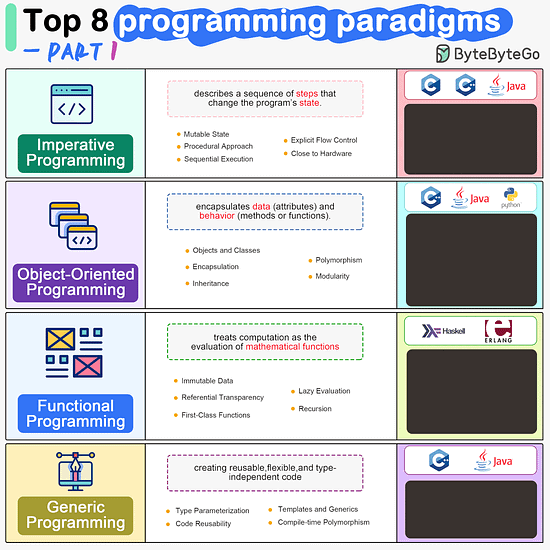
ByteByteGo | Newsletter/Blog
From the newsletter:
Imperative Programming Imperative programming describes a sequence of steps that change the program’s state. Languages like C, C++, Java, Python (to an extent), and many others support imperative programming styles.
Declarative Programming Declarative programming emphasizes expressing logic and functionalities without describing the control flow explicitly. Functional programming is a popular form of declarative programming.
Object-Oriented Programming (OOP) Object-oriented programming (OOP) revolves around the concept of objects, which encapsulate data (attributes) and behavior (methods or functions). Common object-oriented programming languages include Java, C++, Python, Ruby, and C#.
Aspect-Oriented Programming (AOP) Aspect-oriented programming (AOP) aims to modularize concerns that cut across multiple parts of a software system. AspectJ is one of the most well-known AOP frameworks that extends Java with AOP capabilities.
Functional Programming Functional Programming (FP) treats computation as the evaluation of mathematical functions and emphasizes the use of immutable data and declarative expressions. Languages like Haskell, Lisp, Erlang, and some features in languages like JavaScript, Python, and Scala support functional programming paradigms.
Reactive Programming Reactive Programming deals with asynchronous data streams and the propagation of changes. Event-driven applications, and streaming data processing applications benefit from reactive programming.
Generic Programming Generic Programming aims at creating reusable, flexible, and type-independent code by allowing algorithms and data structures to be written without specifying the types they will operate on. Generic programming is extensively used in libraries and frameworks to create data structures like lists, stacks, queues, and algorithms like sorting, searching.
Concurrent Programming Concurrent Programming deals with the execution of multiple tasks or processes simultaneously, improving performance and resource utilization. Concurrent programming is utilized in various applications, including multi-threaded servers, parallel processing, concurrent web servers, and high-performance computing.
#bytebytego#resource#programming#concurrent#generic#reactive#funtional#aspect#oriented#aop#fp#object#oop#declarative#imperative
8 notes
·
View notes
Text
Whats up gamers its me WimpCritic186 here, and welcome to yet another viral Minecraft video. Are you suffering? Are you tired of the tedious march through the morass of grief and heartache life has handed you? Have you heard it said one too many times that the "only way out" is "through"? Well.
In today's redstone tutorial, I will show you how to build what I'm calling the "emotional helicopter", a server-friendly, slime-block-powered redstone contraption I've devised for the express purpose of lifting you up and around difficult emotional barriers in your life without the hassle of actually "processing" your "shit". Don't forget to "Like" this video.
Coming up, I'l test this simple and compact device on two of my friends and fellow DVorceCraft SMP members, Neomilk and banal_lad, who, as you might know, just went through a messy, extremely public breakup. Will Milk and Lad find closure, or will they be caught in the blades? Can 1,600 pistons do what 72 hours of couples-counseling livestreamed over tiktok failed to? And how exactly can a single zombie pigman and an obscure quirk of Minecraft Java's lighting engine combine to form the perfect backdoor into what American psychologist Marsha M. Linehan refers to as the "Wise Mind" in her acclaimed Dialectical Behavioral Therapy framework? Stay tuned for all of this and more, but first, let me take a moment to tell you about Ziploc.
I, WimpCritic186, am thrilled to announce that Ziploc is the sponsor of today's technical minecraft video. Ziploc is a special bag that is extremely pog and goated. As a full time content creator, I have to stay mad organized, and I love using reusable Ziplocbags to store my various gamer items and gamer substances.
Let's talk history. Originally developed and test marketed by The Dow Chemical Company in 1968, Ziploc is an undeniable icon in the crowded sliding-channel-storage-bag market-space, standing head and shoulders above competitors like Glad and Hefty in terms of name recognition and brand loyalty – but it wasn't always that way.
The year is 1951. Danish Inventor Borge Madsen submits a patent application for a new type of plastic slide fastener. Enter businessman and innovator Steven Ausnit. Now, Steven was born in Romania in 1924. His father was Max Ausnit, then regarded as the "The Steel King" of Romania – at least until the fateful day an industry rival falsely accused him of a crime he did not commit, leading to his wrongful conviction and imprisonment. During World War II, after successfully escaping house arrest, … Click To Continue
36 notes
·
View notes
Text
Dev Log Feb 7 2025 - The Stack
Ahoy. This is JFrame of 16Naughts in the first of what I hope will turn out to be a weekly series of developer logs surrounding some of our activities here in the office. Not quite so focused on individual games most of the time, but more on some of the more interesting parts of development as a whole. Or really, just an excuse for me to geek out a little into the void. With introductions out of the way, the first public version of our game Crescent Roll (https://store.steampowered.com/app/3325680/Crescent_Roll juuuust as a quick plug) is due out here at the end of the month, and has a very interesting/unorthodox tech stack that might be of interest to certain devs wanting to cut down on their application install size. The game itself is actually written in Javascript - you know, the scripting language used by your web browser for the interactive stuff everywhere, including here. If you've been on Newgrounds or any other site, they might call games that use it "HTML5" games like they used to call "Flash" games (RIP in peace). Unfortunately, Javascript still has a bit of a sour reputation in most developer circles, and "web game" doesn't really instill much confidence in the gamer either. However, it's turning more and more into the de-facto standard for like, everything. And I do mean everything. 99% of applications on your phone are just websites wrapped in the system view (including, if you're currently using it, the Tumblr app), and it's bleeding more and more into the desktop and other device spaces. Both Android and iOS have calls available to utilize their native web browsers in applications. Windows and Mac support the same thing with WebView2 and WebKit respectively. Heck, even Xbox and Nintendo have a web framework available too (even goes back as far as Flash support for the Wii). So, if you're not using an existing game engine like we aren't and you want to go multi-platform, your choices are either A) Do it in something C/C++ -ish, or now B) Write it in JS. So great - JS runs everywhere. Except, it's not exactly a first-class citizen in any of these scenarios. Every platform has a different SDK for a different low-level language, and none of them have a one-click "bundle this website into an exe" option. So there is some additional work that needs to be done to get it into that nice little executable package.
Enter C#. Everyone calls it Microsoft Java, but their support for it has been absolutely spectacular that it has surpassed Java in pretty much every single possible way. And that includes the number and types of machines that it runs on. The DotNet Core initiative has Mac, Windows, and Linux covered (plus Xbox), Xamarin has Android, and the new stuff for Maui brought iOS into the fold. Write once, run everywhere. Very nice. Except those itty bitty little application lifetime quirks completely change how you do the initialization on each platform, and the system calls are different for getting the different web views set up, and Microsoft is pushing Maui so hard that actually finding the calls and libraries to do the stuff instead of using their own (very strange) UI toolkit is a jungle, but I mean, I only had to write our stream decompression stuff once and everything works with the same compilation options. So yeah - good enough. And fortunately, only getting better. Just recently, they added Web Views directly into Maui itself so we can now skip a lot of the bootstrapping we had to do (I'm not re-writing it until we have to, but you know- it's there for everyone else). So, there you have it. Crescent Roll is a Javascript HTML5 Web Game that uses the platform native Web View through C#. It's a super tiny 50-100MB (depending on the platform) from not having to bundle the JS engine with it, compiles in seconds, and is fast and lean when running and only getting faster and leaner as it benefits from any performance improvements made anywhere in any of those pipeline. And that's it for today's log. Once this thing is actually, you know, released, I can hopefully start doing some more recent forward-looking progress things rather than a kind of vague abstract retrospective ramblings. Maybe some shader stuff next week, who knows.
Lemme know if you have any questions on anything. I know it's kind of dry, but I can grab some links for stuff to get started with, or point to some additional reading if you want it.
3 notes
·
View notes
Text
Best IT Courses In Bhubaneswar:- seeree services pvt ltd.
Introduction:- seeree is one of the best IT training institute and Software industry, features completely Industrial training on Python , PHP , .NET , C Programming,Java , IOT , AI , GD PI , ORACLE and ALL CERTIFICATION COURSES as well as provides seminar,cultural activity and jobs
Courses we provided:- 1) Java Fullstack 2) Python Fullstack 3) PHP Fullstack 4) Preplacement Training & Sp. Eng 5) .NET Fulstack 6) SEO/Digital Marketing 7) SAP 8) MERN 9) Software Testing 10)Data Analyst 11)Data Science 12)Data Engineering 13)PGDCA 14)Tally 15)Graphics Design
Course1:- Java Fullstack

A Class in Java is where we teach objects how to behave. Education at seeree means way to success. The way of teaching by corporate trainers will bloom your career. We have the best java training classes in Bhubaneswar. 100% Placement Support. Job Support Post Training. This course will give you a firm foundation in Java, commonly used programming language. Java technology is wide used currently. Java is a programming language and it is a platform. Hardware or software environment in which a program runs, known as a platform. Since Java has its own Runtime Environment (JRE) and API, it is called platform. Java programming language is designed to meet the challenges of application development in the context of heterogeneous, network-wide distributed environment. Java is an object-oriented programming (OOP) language that uses many common elements from other OOP languages, such as C++. Java is a complete platform for software development. Java is suitable for enterprise large scale applications.]
Course2:- Python Fullstack

Seeree offers best python course in Bhubaneswar with 100% job assurance and low fee. Learn from real time corporate trainers and experienced faculties. Groom your personality with our faculty. Seeree helps to build confidence in students to give exposure to their skills to the company.
Python is dynamically typed , compiled and interpreted , procedural and object oriented , generalized , general-purpose , platform independent programming language. Python is a high-level, structured, open-source programming language that can be used for a wide variety of programming tasks.
Course3:- PHP Fullstack

seeree is the best training institute which provide PHP Training courses in bhubaneswar and all over odisha We aim the students to learn and grow altogether with the need of IT firms.
PHP is a server scripting language, and a powerful tool for making dynamic and interactive Web pages. PHP is a widely-used, free, and efficient alternative to competitors such as Microsoft's ASP.
Course4:- Preplacement Training & Sp. Eng

Welcome to SEEREE Institute, where excellence meets opportunity. At SEEREE, we are dedicated to providing a transformative learning experience that empowers students to achieve their goals and contribute to a brighter future.
Our institute offers cutting-edge courses designed to meet the needs of the ever-evolving global landscape. With a team of highly qualified instructors and state-of-the-art facilities, we ensure a supportive and inspiring environment for learning and growth.
Whether you're here to develop new skills, explore innovative fields, or pursue personal and professional success, SEEREE Institute is the perfect place to begin your journey. Thank you for choosing us, and we look forward to being a part of your success story.
Course5:- .NET Fullstack

Seeree offers best .NET course in Bhubaneswar with 100% job assurance and low fee. Learn from real time corporate trainers and experienced faculties. Groom your personality with our faculty. Seeree helps to build confidence in students to give exposure to their skills to the company.
Course6:- SEO/Digital Marketing

In today's fast-paced digital world, businesses thrive on visibility, engagement, and strategic online presence. At SEEREE, we empower you with the skills and knowledge to master the art of Search Engine Optimization (SEO) and Digital Marketing.
Our comprehensive program is designed for beginners and professionals alike, covering everything from keyword research, on-page and off-page SEO, and content marketing, to social media strategies, PPC campaigns, and analytics.
With hands-on training, real-world projects, and guidance from industry experts, we ensure you're equipped to drive measurable results and excel in this dynamic field.
Join us at SEEREE Institute and take the first step towards becoming a leader in the digital marketing landscape!"
Course7:- SAP

SAP refers to Systems, Applications, and Products in Data Processing. Some of the most common subjects covered in these courses include human resource software administration, database management, and business training. Obtaining SAP certification can be done on a stand-alone basis or as part of a degree program.
Course8:- MERN

Seeree offers the best MERN course in Bhubaneswar with 100% job assurance and low fees. Learn from real-time corporate trainers and experienced faculty. Seeree helps students build confidence and gain skills to excel in company roles.
Are you ready to step into the exciting world of web development? At SEEREE, we bring you a comprehensive MERN Stack course that equips you with the skills to build modern, dynamic, and responsive web applications from start to finish.
The MERN Stack—comprising MongoDB, Express.js, React.js, and Node.js—is one of the most sought-after technologies in the web development industry. Our program is designed to help you master each component of the stack, from creating robust backends and managing databases to crafting dynamic frontends and seamless APIs.
Course9:- Software Testing

Seeree offers best Testing course in Bhubaneswar with 100% job assurance and low fee. Learn from real time corporate trainers and experienced faculties. Groom your personality with our faculty. Seeree helps to build confidence in students to give exposure to their skills to the company.
In the fast-paced world of software development, ensuring the quality and reliability of applications is crucial. At SEEREE, we offer a comprehensive Software Testing course designed to equip you with the skills and techniques needed to excel in this essential field.
Our program covers all aspects of software testing, from manual testing fundamentals to advanced automation tools and frameworks like Selenium, JIRA, and TestNG. You’ll learn to identify bugs, write test cases, execute test scripts, and ensure software meets high-quality standards.
With hands-on training, real-world scenarios, and guidance from experienced industry professionals, you’ll be prepared to take on roles like Quality Assurance Engineer, Test Analyst, and Automation Tester.
Join SEEREE Institute and gain the expertise to become a key player in delivering flawless software solutions. Your journey to a rewarding career in software testing starts here!"
Course10:- Data Analyst

Seeree offers the best Data Analyst course in Bhubaneswar with 100% job assurance and affordable fees. Our comprehensive curriculum is designed to cover all aspects of data analysis, from data collection and cleaning to advanced data visualization techniques. Learn from real-time corporate trainers and experienced faculty members who bring industry insights into the classroom. Enhance your analytical skills and boost your career prospects with hands-on projects and real-world case studies. Our faculty also focuses on grooming your personality and soft skills, ensuring you are well-prepared for interviews and workplace environments. Seeree is dedicated to building confidence in students, providing them with the necessary exposure to showcase their skills to top companies in the industry.
Course11:- Data Science

Seeree offers the best Data Science course in Bhubaneswar with 100% job assurance and affordable fees. Our comprehensive curriculum is designed to cover all aspects of data science, from data collection and cleaning to advanced data visualization techniques. Learn from real-time corporate trainers and experienced faculty members who bring industry insights into the classroom. Enhance your analytical skills and boost your career prospects with hands-on projects and real-world case studies. Our faculty also focuses on grooming your personality and soft skills, ensuring you are well-prepared for interviews and workplace environments. Seeree is dedicated to building confidence in students, providing them with the necessary exposure to showcase their skills to top companies in the industry.
Course12:- Data Engineering
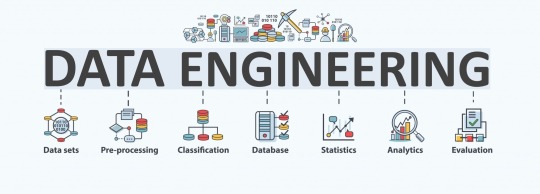
In the era of big data, the ability to design, build, and manage scalable data infrastructure is one of the most in-demand skills in the tech industry. At SEEREE, we are proud to offer a comprehensive Data Engineering course that prepares you for a career at the forefront of data-driven innovation.
Our program covers essential topics such as data modeling, ETL processes, data warehousing, cloud platforms, and tools like Apache Spark, Kafka, and Hadoop. You’ll learn how to collect, organize, and transform raw data into actionable insights, enabling businesses to make smarter decisions.
With real-world projects, expert mentorship, and hands-on experience with the latest technologies, we ensure that you are industry-ready. Whether you’re starting fresh or upskilling, this program will empower you to unlock opportunities in the rapidly growing field of data engineering.
Join SEEREE Institute and take the first step toward building the data pipelines that power tomorrow’s technology!"
Course13:- PGDCA

Seeree offers the best MERN course in Bhubaneswar with 100% job assurance and low fees. Learn from real-time corporate trainers and experienced faculty. Seeree helps students build confidence and gain skills to excel in company roles.
In today’s digital age, computer applications are at the heart of every industry, driving innovation and efficiency. At SEEREE Institute, our Post Graduate Diploma in Computer Applications (PGDCA) program is designed to provide you with in-depth knowledge and hands-on skills to excel in the IT world.
This program offers a comprehensive curriculum covering programming languages, database management, web development, software engineering, networking, and more. Whether you aim to enhance your technical expertise or step into a rewarding career in IT, PGDCA at SEEREE equips you with the tools to succeed.
With expert faculty, state-of-the-art labs, and real-world projects, we ensure that you gain practical experience and a strong theoretical foundation. By the end of the program, you’ll be prepared for roles such as software developer, system analyst, IT manager, or database administrator.
Course14:- Tally
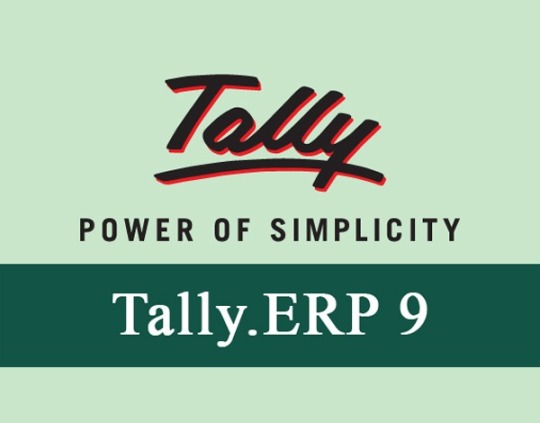
Seeree offers the best Tally course in Bhubaneswar with 100% job assurance and low fees. Learn from real-time corporate trainers and experienced faculty. Seeree helps students build confidence and gain skills to excel in company roles.
In today’s business world, efficient financial management is key to success, and Tally is one of the most trusted tools for accounting and financial operations. At SEEREE Institute, we offer a comprehensive Tally course designed to equip you with the skills needed to manage business finances effortlessly.
Our program covers everything from the basics of accounting and bookkeeping to advanced features like GST compliance, inventory management, payroll processing, and generating financial reports. With hands-on training and real-world applications, you’ll gain practical expertise in using Tally effectively for businesses of any scale.
Whether you're a student, a professional, or a business owner, our Tally program is tailored to meet your needs and enhance your career prospects in the fields of accounting and finance.
Course15:- Graphics Design

In the world of creativity and communication, graphic design plays a vital role in bringing ideas to life. At SEEREE Institute, our Graphic Design course is tailored to help you unlock your creative potential and master the art of visual storytelling.
Our program covers a wide range of topics, including design principles, color theory, typography, branding, and user interface design. You’ll gain hands-on experience with industry-standard tools like Adobe Photoshop, Illustrator, and InDesign, enabling you to create stunning visuals for print, digital media, and beyond.
Whether you're an aspiring designer or a professional looking to sharpen your skills, our expert trainers and real-world projects will provide you with the knowledge and confidence to excel in this competitive field.
Join SEEREE Institute and start your journey toward becoming a skilled graphic designer. Let’s design your future together!"
2 notes
·
View notes
Text
My First Java Program: A Journey into Coding

Starting with Java programming can be an exciting journey, filled with discovery, challenges, and a sense of accomplishment. My experience of writing my first Java program was a significant milestone that opened up a world of possibilities in software development. In this blog, I’ll share my journey through writing my first Java program, along with the concepts I learned and the obstacles I overcame.
The Excitement of Starting
When I first decided to learn Java, I was motivated by its versatility and widespread use in developing applications, from mobile apps to enterprise software. I had heard about the power of Java and how it is a foundational language for many developers. After setting up my Java development environment, which included installing the Java Development Kit (JDK) and choosing an Integrated Development Environment (IDE) like Eclipse, I was ready to dive in.
The anticipation of writing my first program filled me with excitement. I had heard many experienced programmers talk about how exhilarating it felt to see their code come to life, and I was eager to experience that feeling myself.
Setting Up the Development Environment
Before I could write my first program, I needed to ensure my development environment was properly configured. Here’s a brief overview of how I set it up:
1. Installing the JDK: I downloaded the latest version of the Java Development Kit from the Oracle website. This included everything I needed to compile and run Java applications.
2. Choosing an IDE: I chose Eclipse as my IDE because of its robust features and user-friendly interface. After downloading and installing it, I was ready to start coding.
3. Verifying the Installation: I opened the command prompt (or terminal) and typed java -version to confirm that Java was installed correctly. Seeing the version number displayed confirmed that I was on the right track.
Writing My First Java Program
With my development environment set up, I was finally ready to write my first Java program. Following the traditional approach, I decided to create a simple “Hello, World!” program. This classic exercise is often the first step for beginners learning any programming language.
Step 1: Creating a New Java Project
In Eclipse, I created a new Java project:
1. File > New > Java Project.
2. I named the project “HelloWorld” and clicked Finish.
Step 2: Creating a New Java Class
Next, I created a new Java class within the project:
1. Right-click on the src folder in the HelloWorld project.
2. Selected New > Class.
3. I named the class HelloWorld and checked the box to include the public static void main(String[] args) method. This method is the entry point of any Java application.
Step 3: Writing the Code
With the class created, I wrote the code that would print “Hello, World!” to the console:
public class HelloWorld { public static void main(String[] args) { System.out.println(“Hello, World!”); } }
Code Explanation
public class HelloWorld: This line defines a public class named HelloWorld. In Java, every application must have at least one class.
public static void main(String[] args): This line declares the main method, which is the starting point of any Java program. The JVM (Java Virtual Machine) looks for this method when executing the program.
System.out.println(“Hello, World!”);: This line prints the string “Hello, World!” to the console. The System.out object is used to output data to the console, and println is a method that prints the text followed by a newline.
Step 4: Running the Program
After writing the code, it was time to run my program and see the result:
1. I right-clicked on the HelloWorld.java file in the Project Explorer.
2. Selected Run As > Java Application.
To my delight, the console displayed the message “Hello, World!” It was a simple program, but seeing the output felt like a monumental achievement. I had successfully written and executed my first Java program!
Learning from the Experience
The process of writing my first Java program taught me several important lessons:
Understanding Java Syntax
Java has a specific syntax that must be followed. This includes rules about naming conventions, the use of semicolons to end statements, and the structure of classes and methods. Understanding these rules is essential for writing valid Java code.
The Importance of the Main Method
The main method is crucial in Java applications. It serves as the entry point, and every program must have it to be executed. Learning this concept helped me appreciate how Java applications are structured.
The Power of Output Statements
Using System.out.println() was my first experience with output statements. It highlighted the importance of feedback in programming. Being able to print messages to the console is invaluable for debugging and understanding program flow.
Overcoming Challenges
While writing my first Java program was largely straightforward, I faced some challenges along the way:
Syntax Errors
Initially, I encountered syntax errors due to missing semicolons or misnamed classes. Each error message provided insight into what I needed to correct. This experience emphasized the importance of careful coding and attention to detail.
Understanding the IDE
Familiarizing myself with Eclipse took some time. I had to learn how to navigate the interface, manage projects, and use features like code suggestions and debugging tools. As I continued coding, I became more comfortable with the IDE.
Next Steps in My Java Journey
Completing my first Java program was just the beginning. With a foundational understanding of Java syntax and structure, I was excited to explore more advanced concepts. Here are the next steps I took in my learning journey:
Exploring Java Basics
I delved deeper into Java basics, including:
Data Types: Understanding primitive and reference data types.
Variables: Learning how to declare and use variables effectively.
Operators: Exploring arithmetic, relational, and logical operators.
Control Flow Statements: Mastering if-else, switch, and loop constructs.
Learning Object-Oriented Programming (OOP)
Java is an object-oriented programming language, and I knew I had to understand OOP principles. I focused on concepts such as:
Classes and Objects: Learning how to create and manipulate objects.
Inheritance: Understanding how classes can inherit properties from other classes.
Encapsulation: Learning how to hide data within classes.
Polymorphism: Exploring method overloading and overriding.
Building Projects
I started working on small projects to apply my knowledge. Simple applications, like a calculator or a text-based game, helped solidify my understanding of Java concepts.
Conclusion
Writing my first Java program was a thrilling experience that marked the beginning of my journey as a programmer. The excitement of seeing my code come to life, coupled with the knowledge I gained, fueled my desire to continue learning and growing in the field of software development.
Java has proven to be a powerful language with endless possibilities, and I am eager to explore its depths further. With each program I write, I feel more confident in my coding abilities and more inspired to tackle new challenges.
If you’re starting your Java journey, embrace the process, celebrate your successes, and don’t shy away from challenges. Each step you take brings you closer to becoming a proficient Java developer.
Happy coding!
2 notes
·
View notes
Text
From 'Write Once, Run Anywhere' to Strong Security: The Java Advantage
Java, a programming language and technology ecosystem, has solidified its place in the digital world as a versatile and powerful tool. With its "Write Once, Run Anywhere" capability and an extensive array of features, Java has been instrumental in diverse domains, from mobile app development to building enterprise-level systems. This blog explores the strengths of Java, including its portability, robustness, vast ecosystem, and the thriving community that supports it. We will also discuss the value of structured training and the role of ACTE Technologies in nurturing your Java skills. By the end of this journey, you'll have a deep appreciation for the enduring excellence of Java and its role in the ever-evolving tech industry.
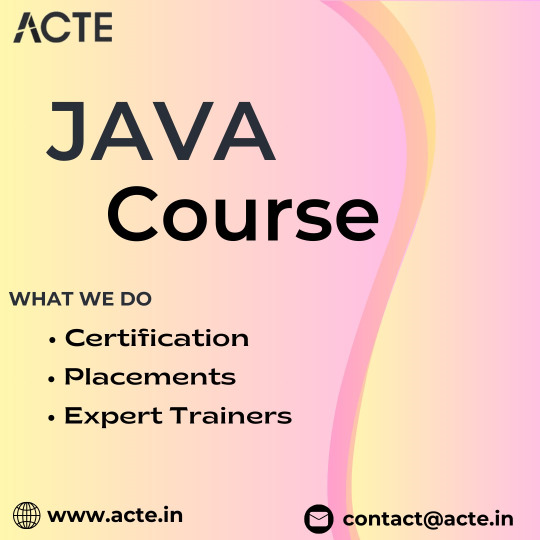
The Power and Versatility of Java:
1. Portability and Cross-Platform Compatibility:
Java's claim to fame, "Write Once, Run Anywhere," is not just a marketing slogan. It's a fundamental principle of Java that sets it apart. This feature is made possible by the Java Virtual Machine (JVM), which allows Java code to run on any platform that has a compatible JVM. This portability has been a game-changer, especially in a world where a diverse range of devices and operating systems coexist. Whether it's Windows, macOS, or Linux, Java applications run seamlessly, eliminating compatibility issues and reducing development time and effort.
2. Robust and Secure:
Java's architecture prioritizes robustness and security. It employs strong type checking, automatic memory management (garbage collection), and comprehensive exception handling. These features make Java code less prone to common programming errors and vulnerabilities. For businesses and organizations where system reliability and data security are critical, Java's robustness and built-in security mechanisms make it a go-to choice. Critical systems, such as banking applications, rely on Java to ensure the highest level of protection against errors and threats.
3. Vast Ecosystem:
The Java ecosystem is vast and varied. It includes an extensive library of classes, frameworks, and tools that cater to a wide range of application development needs. Some of the notable components of this ecosystem include:
Java Standard Library: Java's standard library provides a wealth of pre-built classes and utilities for common programming tasks, simplifying development.
Enterprise JavaBeans (EJB): For enterprise-level applications, EJB offers a framework for building scalable, distributed, and transactional components.
JavaServer Pages (JSP) and Servlets: These technologies enable the development of dynamic web applications, making Java a popular choice for web development.
Spring Framework: Spring is a comprehensive framework for building enterprise-level applications, offering features like dependency injection, aspect-oriented programming, and more.
Android Development: Java serves as the primary language for developing Android mobile applications, further expanding its reach.
4. Community and Support:
Java's success is not only due to its technical prowess but also its thriving community of developers, enthusiasts, and experts. This community-driven approach ensures that Java remains relevant, up-to-date, and aligned with industry best practices. Developers can find a wealth of resources, forums, and collaborative environments where they can learn, share knowledge, and solve challenges. The community's collective wisdom and problem-solving spirit have contributed to the continuous evolution of Java.
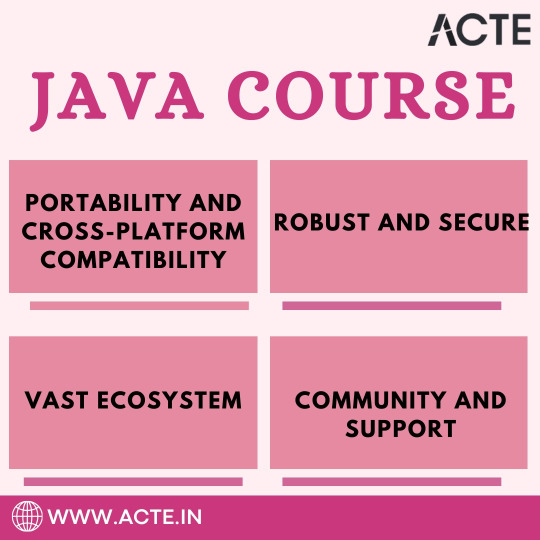
Java's enduring excellence is a testament to its portability, robustness, vast ecosystem, and strong community support. If you're looking to harness the potential of Java and embark on a journey of learning and mastery, consider exploring the Java training programs offered by ACTE Technologies. With dedication and the right resources, you can leverage Java's capabilities and contribute to the ever-evolving tech landscape.
Java has stood the test of time, offering unparalleled portability, robustness, a rich ecosystem, and a vibrant community. Whether you're building enterprise-level applications or dynamic web services, Java remains a reliable choice. ACTE Technologies' structured training can help you unlock the full potential of Java, enabling you to thrive in the dynamic tech industry.
8 notes
·
View notes
Text
Understanding Object-Oriented Programming and OOPs Concepts in Java
Object-oriented programming (OOP) is a paradigm that has revolutionized software development by organizing code around the concept of objects. Java, a widely used programming language, embraces the principles of OOP to provide a robust and flexible platform for developing scalable and maintainable applications. In this article, we will delve into the fundamental concepts of Object-Oriented Programming and explore how they are implemented in Java.

Object-Oriented Programming:
At its core, Object-Oriented Programming is centered on the idea of encapsulating data and behavior into objects. An object is a self-contained unit that represents a real-world entity, combining data and the operations that can be performed on that data. This approach enhances code modularity, and reusability, and makes it easier to understand and maintain.
Four Pillars of Object-Oriented Programming:
Encapsulation: Encapsulation involves bundling data (attributes) and methods (functions) that operate on the data within a single unit, i.e., an object. This encapsulation shields the internal implementation details from the outside world, promoting information hiding and reducing complexity.
Abstraction: Abstraction is the process of simplifying complex systems by modeling classes based on essential properties. In Java, abstraction is achieved through abstract classes and interfaces. Abstract classes define common characteristics for a group of related classes, while interfaces declare a set of methods that must be implemented by the classes that implement the interface.
Inheritance: Inheritance is a mechanism that allows a new class (subclass or derived class) to inherit properties and behaviors of an existing class (superclass or base class). This promotes code reuse and establishes a hierarchy, facilitating the creation of specialized classes while maintaining a common base.
Polymorphism: Polymorphism allows objects of different types to be treated as objects of a common type. This is achieved through method overloading and method overriding. Method overloading involves defining multiple methods with the same name but different parameters within a class, while method overriding allows a subclass to provide a specific implementation of a method that is already defined in its superclass.
Java Implementation of OOP Concepts:
Classes and Objects: In Java, a class is a blueprint for creating objects. It defines the attributes and methods that the objects of the class will have. Objects are instances of classes, and each object has its own set of attributes and methods. Classes in Java encapsulate data and behavior, fostering the principles of encapsulation and abstraction.
Abstraction in Java: Abstraction in Java is achieved through abstract classes and interfaces. Abstract classes can have abstract methods (methods without a body) that must be implemented by their subclasses. Interfaces declare a set of methods that must be implemented by any class that implements the interface, promoting a higher level of abstraction.
Inheritance in Java: Java supports single and multiple inheritances through classes and interfaces. Subclasses in Java can inherit attributes and methods from a superclass using the extends keyword for classes and the implements keyword for interfaces. Inheritance enhances code reuse and allows the creation of specialized classes while maintaining a common base.
Polymorphism in Java: Polymorphism in Java is manifested through method overloading and overriding. Method overloading allows a class to define multiple methods with the same name but different parameters. Method overriding occurs when a subclass provides a specific implementation for a method that is already defined in its superclass. This enables the use of a common interface for different types of objects.
Final Thoughts:
Object-oriented programming and its concepts form the foundation of modern software development. Java, with its robust support for OOP, empowers developers to create scalable, modular, and maintainable applications. Understanding the principles of encapsulation, abstraction, inheritance, and polymorphism is crucial for harnessing the full potential of OOPs concepts in Java. As you continue your journey in software development, a solid grasp of these concepts will be invaluable in designing efficient and effective solutions.
#javascript#javaprogramming#java online training#oops concepts in java#object oriented programming#education#technology#study blog#software#it#object oriented ontology#java course
3 notes
·
View notes
Text
Computer Language
Computer languages, also known as programming languages, are formal languages used to communicate instructions to a computer. These instructions are written in a syntax that computers can understand and execute. There are numerous programming languages, each with its own syntax, semantics, and purpose. Here are some of the main types of programming languages:
1.Low-Level Languages:
Machine Language: This is the lowest level of programming language, consisting of binary code (0s and 1s) that directly corresponds to instructions executed by the computer's hardware. It is specific to the computer's architecture.
Assembly Language: Assembly language uses mnemonic codes to represent machine instructions. It is a human-readable form of machine language and closely tied to the computer's hardware architecture
2.High-Level Languages:
Procedural Languages: Procedural languages, such as C, Pascal, and BASIC, focus on defining sequences of steps or procedures to perform tasks. They use constructs like loops, conditionals, and subroutines.
Object-Oriented Languages: Object-oriented languages, like Java, C++, and Python, organize code around objects, which are instances of classes containing data and methods. They emphasize concepts like encapsulation, inheritance, and polymorphism.
Functional Languages: Functional languages, such as Haskell, Lisp, and Erlang, treat computation as the evaluation of mathematical functions. They emphasize immutable data and higher-order functions.
Scripting Languages: Scripting languages, like JavaScript, PHP, and Ruby, are designed for automating tasks, building web applications, and gluing together different software components. They typically have dynamic typing and are interpreted rather than compiled.
Domain-Specific Languages (DSLs): DSLs are specialized languages tailored to a specific domain or problem space. Examples include SQL for database querying, HTML/CSS for web development, and MATLAB for numerical computation.
3.Other Types:
Markup Languages: Markup languages, such as HTML, XML, and Markdown, are used to annotate text with formatting instructions. They are not programming languages in the traditional sense but are essential for structuring and presenting data.
Query Languages: Query languages, like SQL (Structured Query Language), are used to interact with databases by retrieving, manipulating, and managing data.
Constraint Programming Languages: Constraint programming languages, such as Prolog, focus on specifying constraints and relationships among variables to solve combinatorial optimization problems.
2 notes
·
View notes
Text
Deciding Between Selenium with Python and Selenium with Java: An In-Depth Comparison
In the domain of automated testing, Selenium emerges as a pivotal tool for ensuring the reliability and quality of web applications. When it comes to selecting the programming language to harness Selenium's capabilities, two prominent contenders often come into play: Python and Java. Both languages offer distinct advantages and considerations, making the decision between them crucial for any automation project.

In this blog post, we'll conduct a thorough comparison of Selenium with Python and Selenium with Java, exploring their unique strengths, use cases, and factors to consider. By the end, readers will have a clearer understanding of which option aligns best with their project requirements, team proficiencies, and organizational objectives.
Python with Selenium:
Python, celebrated for its simplicity and readability, has garnered significant traction within the automation testing community. Let's delve into some key benefits of leveraging Python with Selenium:
Simplicity and Readability: Python's hallmark characteristics include simplicity and readability. Its concise syntax enables developers to express ideas in fewer lines of code, resulting in scripts that are easier to comprehend and maintain. For testers, this translates to expedited development cycles and reduced overhead in managing test suites.
Extensive Ecosystem: Python boasts a vast ecosystem of libraries and frameworks that complement Selenium, augmenting its capabilities for test automation. Whether handling data manipulation, conducting API testing, or generating test reports, Python's rich library support caters to diverse automation needs. Furthermore, the active Python community ensures an abundance of resources, tutorials, and documentation to aid testers throughout the automation journey.
Rapid Prototyping: Python's dynamic nature lends itself well to rapid prototyping and iterative development. Testers can swiftly experiment with different approaches, adapt scripts on-the-go, and respond promptly to evolving requirements. This flexibility seamlessly aligns with agile development methodologies, empowering teams to deliver high-quality software with agility.
Integration Compatibility: Python's interoperability with other tools and technologies makes it an appealing choice for Selenium automation. Whether integrating with continuous integration (CI) pipelines, test reporting frameworks, or version control systems, Python's versatility ensures smooth interoperability, streamlining the testing workflow and bolstering overall efficiency.

Java with Selenium:
Java, renowned for its robustness and performance, has long been a cornerstone in enterprise software development. Here are some compelling reasons to consider Java for Selenium automation:
Robustness and Performance: Java's static typing and strong object-oriented principles contribute to the robustness and performance of Selenium test suites. Its compile-time error checking aids in identifying potential issues early in the development phase, resulting in more stable and reliable automation scripts. For large-scale enterprise projects with stringent quality requirements, Java's reliability is a significant asset.
Widespread Adoption: Java enjoys widespread adoption within the enterprise landscape, making it a natural choice for organizations with existing Java codebases or a Java-centric development environment. The abundance of Java expertise in the workforce, coupled with extensive community support and industry recognition, solidifies its status as a preferred language for Selenium automation in many corporate settings.
Mature Tooling: Java's mature ecosystem of testing tools and frameworks, including JUnit and TestNG, seamlessly integrate with Selenium to offer comprehensive test automation solutions. These frameworks furnish advanced features such as parameterized testing, parallel execution, and built-in reporting capabilities, empowering testers to design and execute sophisticated test suites effortlessly.
Enterprise Support: Java's popularity in enterprise environments translates to robust support from vendors, extensive documentation, and a plethora of third-party integrations. For organizations seeking enterprise-grade features, reliability, and scalability in their Selenium automation endeavors, Java's ecosystem and support infrastructure present a compelling value proposition.
Conclusion:
In summary, both Selenium with Python and Selenium with Java present compelling options for test automation, each with its unique strengths and considerations. Python excels in simplicity, rapid development, and a vast ecosystem, making it an ideal choice for agile teams and projects with evolving requirements. Conversely, Java offers robustness, performance, and widespread enterprise support, rendering it well-suited for large-scale enterprise applications with stringent quality standards.
Ultimately, the decision between Python and Java for Selenium automation hinges on various factors such as project prerequisites, team proficiencies, and organizational preferences. By meticulously evaluating these factors and weighing the pros and cons of each option, stakeholders can make informed decisions that align with their specific needs and aspirations. Whether opting for the simplicity of Python or the robustness of Java, Selenium remains an indispensable tool for driving quality and efficiency in web application testing.
2 notes
·
View notes